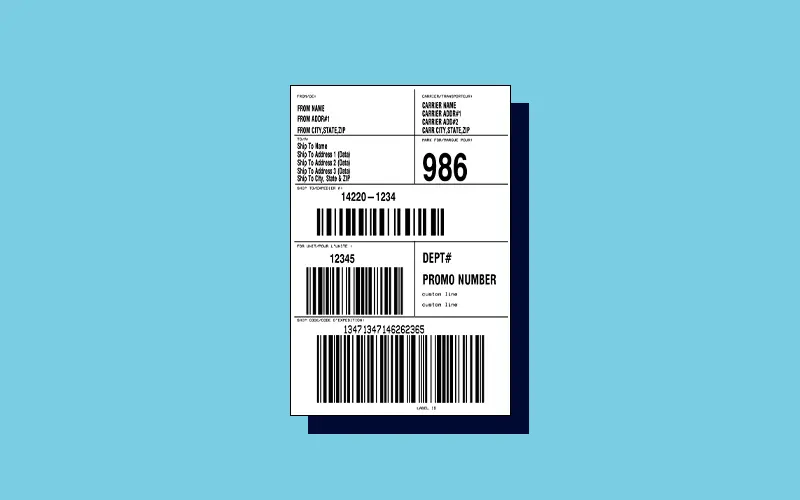According to a study by Gartner, 80% of companies worldwide expect regulatory complexity to increase in the next three years. Enterprise labeling tools have become indispensable in handling compliance issues. But it’s not just due to increased regulatory complexity – rising consumer demands, supply chain disruptions, e-commerce growth, and emerging technologies all contribute to the ever-growing need for organizations to make sure their labeling operations are running more efficiently and can handle sudden changes.
Enterprise labeling software combines compliance labeling with cost-effective solutions. A company can manage compliance labeling, product variants, and more with the help of enterprise labeling software. It is essential to integrate enterprise labeling software with existing enterprise applications and key data sources. This will help automate labeling processes and avoid costly mislabeling.
What is Enterprise Labeling?
As businesses expand, labeling is increasingly an essential part of a company’s supply chain. Changing customer demands, global regulations and industry standards require an efficient and scalable labeling solution to keep operations running smoothly.
Errors in labeling can be expensive; errors caused by data source, printer or label can disrupt entire production lines and lead to a significant financial loss. With label management streamlined and centralized, organizations can avoid costly delays and rework.
This software is especially useful for companies with global supply chains. It helps organizations improve accuracy and reduce costs by automatically printing variable data based on business rules. It can use external data sources to populate fields on labels and deploy changes to labels within minutes. It also helps businesses cut data storage costs. In addition to its cost benefits, enterprise labeling software can increase profitability through faster turnaround times and improved accuracy.
Choosing the right enterprise labeling software depends on several factors. A reliable solution should eliminate manual processes. A good enterprise labeling software should use thermal transfer and multi-platform software. This will allow for easy access to labels from any location and any printer with an internet connection. An enterprise labeling solution should also provide on-demand label printing and encryption.
As global business environments have become more complex, companies must think about labeling differently. Today’s dynamic supply chains require flexible, reliable, and scalable labeling. With the help of a cloud-based labeling software, businesses can easily make changes to their labeling systems to meet new demands and comply with corporate standards. Furthermore, cloud-based labeling also allows businesses to implement changes quickly and uniformly across all global locations.
5 Features Your Enterprise Labeling Software Should Have
In today’s multi-faceted and dynamic supply chain, labeling has never been more important. It is one of the most crucial links in the entire manufacturing/distribution process. Here are a few enterprise labeling software features your system should offer your organization.
- Design: Enterprise labeling software should allow you to create and design labels that are visually appealing and easy to read. This includes the ability to add text, images, barcodes, and other graphics.
- Data integration: Enterprise labeling software should be able to integrate with your existing data sources, such as your ERP system or CRM system. This allows you to automatically populate labels with data from your existing systems.
- Label printing: Enterprise labeling software should allow you to print labels in a variety of formats, including thermal transfer, direct thermal, and laser. It should also allow you to print labels in bulk, which can save you time and money.
- Label management: Enterprise labeling software should allow you to manage your labels, including creating and editing label templates, assigning labels to products or jobs, and tracking label usage.
- Security: Enterprise labeling software should be secure to protect your data. This includes features such as user authentication, data encryption, and access control.
Top Benefits of Enterprise Labeling
Workflow Automation
Using workflows to automate your processes is a good idea for businesses that are growing or have a large volume of work. Automated workflows can help streamline workflows and eliminate human error.
Workflows can be automated using software or through manual assignments. Using workflows to automate some tasks can save time and money. For example, a workflow can be used to send a contract electronically for signing. This can save time and eliminate security risks.
A good workflow solution should include features such as visual representation of workflows, the ability to create diagrams and reports, and a tool that is easy to use. A workflow tool should also be able to sync with multiple tools. It should also be able to automate general updates, content creation, and social media posts.
A workflow is a set of rules that route tasks from one place to another. It may be static or dynamic. Using workflows to automate tasks can help companies respond to customer inquiries and manage their business better. It may also help boost productivity.
Automating your workflow can help companies save money and improve customer satisfaction. It can also reduce employee frustration. In addition to reducing wasteful spending, streamlining operations can help increase margins. It can also help companies respond faster to customer requests.
A workflow is also a good way to keep teams accountable. Using workflows to automate the process of assigning contacts to team members can be useful. This can reduce human error and keep team members on task.
A workflow can also be a good way to keep track of your most important tasks. It can also save time by eliminating rote tasks.
Reduction of Print Streams to Minimize Network Traffic
Using an enterprise labeling solution for your business printing needs can help you reduce print streams to minimize network traffic. It also helps you minimize maintenance and costs. Besides, enterprise labeling solutions can also help you get the most out of your printer investment. Whether you print on paper or in the cloud, you need a solution that meets your needs and provides you with the performance and flexibility you need to succeed.
One of the most common requirements for labeling is the ability to manage workflows. Enterprise Labeling Solutions enable companies to streamline workflows by implementing a central system that is easily accessible from anywhere. This allows companies to scale and manage their labels at any location, without the need to add resources. It also gives them the ability to access data from systems of record.
A comprehensive audit reporting feature is especially important in validated environments. This provides audit trails and graphical views of all labels that have been printed. It also allows users to monitor the status of workflows and print requests. This information can improve production processes.
It also helps you increase productivity by reducing errors and simplifying complex printing processes. You also have the ability to create custom printing applications. Besides, the automation module includes workflows, business connectors, and data mapping.
In addition, Enterprise Labeling Solutions include native printer drivers that minimize network traffic. They also support a wide range of printers. This allows companies to meet their high-volume global printing needs without the need to maintain windows drivers. The native drivers also help reduce the size of print streams that are delivered over the Internet.
It also offers real-time alerts for connected printers. These alerts provide a real-time overview of active print jobs. This feature helps users keep track of all their labeling requirements and the status of each print request.

Increased Productivity
Labeling has become a critical part of every company’s supply chain, but many organizations still use fragmented systems that create inefficiencies and cause production delays. Enterprise labeling software is an effective way to improve accuracy and streamline workflows.
When businesses integrate labeling into their business applications, they can unlock a host of benefits, including increased productivity. For example, integrating a labeling solution with a data-driven ERP system allows businesses to update the label specifications based on the rules in their ERP system.
This ability to do this makes it easier for businesses to meet compliance requirements, improve brand integrity and reduce costs. Moreover, it also increases efficiency. By reducing redundancies, enterprise labeling solutions eliminate unnecessary maintenance, which can save businesses time and money.
Reduced Redundancy
Redundancy is a way to ensure that your systems function properly when something goes wrong. It can come in the form of a backup system or a cloud service, and can help prevent revenue loss from downtime.
Redundant networks can keep your business running if something unexpected happens, such as a power failure or city-wide blackout. They are designed to restore network services as soon as possible to ensure your customers’ continued access to your services.
Enterprise labeling also makes it easier for you to meet regulatory requirements, including GHS. It can automatically pull data from your ERP, WMS, SDS and other business applications, reducing errors and waste.
In addition, the centralized visibility and control that enterprise labeling provides can help you make more efficient changes to labels based on new products or regulations. This can result in faster cycle times and reduced costs.
Ensure Disaster Recovery and Business Continuity
Ensure disaster recovery and business continuity with enterprise labeling. Businesses are increasingly dependent on information technology. Without the proper plans in place, information can be compromised and impact your business.
In addition, without a plan, your business could suffer a significant loss of revenue. Employees could become unproductive and you could even suffer damage to your reputation. A well-planned and documented business continuity and disaster recovery plan can ensure that you are back in business as quickly as possible after a disaster.
Business continuity and disaster recovery plans can be complicated. They need to be reviewed regularly and should be able to account for a variety of scenarios. The plans should also take into account your business’s critical functions and facilities.
The key to ensuring business continuity and disaster recovery is to develop a comprehensive plan that addresses the needs of your organization and its business partners. Without a plan, your business could suffer financial losses, damage to your reputation and unproductive employees.
Disaster recovery is the process of restoring your business’s IT systems and data after a disaster. In addition to IT systems, the plan should also include procedures for how to restore communications between emergency staff and business partners.
The plan may also include a list of critical supplies and employee contact information. It should also address how to deal with any data breaches. It can also include a schedule for testing and updating the plan.
Disaster recovery and business continuity are crucial to any business. Without a plan, your business could become unproductive and suffer a significant loss of revenue. Employees may become injured, your business’s reputation may be damaged and you could even suffer damage to your business.

Picking the Right Enterprise Labeling Software
Picking the right enterprise labeling software helps you create and print labels quickly, efficiently, and accurately. It also allows you to ensure compliance with all of your labeling needs, including FDA and GS1 regulations and industry standards. Ultimately, it can help you save money and streamline your labeling process.
When your business is in the midst of growing, it is important to maintain an efficient and accurate labeling process. Without an effective, compliant system, it can be challenging to stay ahead of regulatory and customer demands.
Fortunately, there are many labeling solutions available for different needs and budgets. However, it is important to know which solution will best suit your business and your goals before you commit to one.
Automated, compliant labels and barcodes are an investment that will pay off in the long run for your business.
A smart and scalable labeling solution can reduce costs, eliminate errors, and provide valuable data to your business. Whether you are looking for an integrated, cloud-based enterprise labeling solution or a standalone barcode and labeling application, there are plenty of options available to meet your requirements.
Dynamic, real-time labeling is a key trend driving the market.
Businesses are increasingly adopting dynamic labeling as a way to streamline their labeling processes and ensure that they are meeting all of their requirements. This allows them to make updates and changes on a frequent basis. These updates can include language, regional, or customer-specific information.
The ability to manage all of your labeling in a single system is a major benefit for any enterprise.
A unified, centralized labeling solution provides one point of control for everything from label design to approval to printing to reporting. It can easily be customized to your specific labeling needs, ensuring you get the most out of your enterprise labeling investments.
Increase the efficiency of your labeling process by integrating with ERP and other systems.
A centrally managed labeling solution enables you to take full advantage of your existing ERP and other systems by allowing you to manage your entire labeling workflow from design to production, minimizing the risk of data inconsistencies that can cost your business valuable time and money.

















